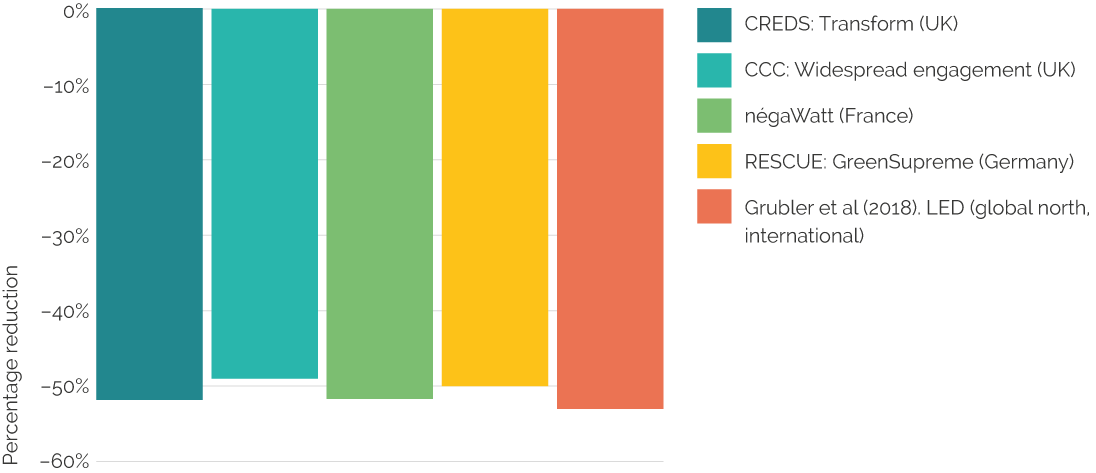Five independent low energy demand scenarios come to very similar conclusions about the potential for energy demand reduction in support of the net-zero target.
In response to mitigating climate change, several scenarios have been developed that explore the maximum possible potential of energy demand reduction (EDR) or social change across the UK, Europe and internationally by 2050.
These scenarios include:
- CREDS Positive Low Energy Futures scenarios for the UK
- The CCC’s Sixth Carbon Budget (UK)
- The Grubler Low Energy Demand (LED) scenario (Grubler et al., 2018) for the global north
- négaWatt Association’s energy transition pathway for France
- Resource-Efficient Pathways towards Greenhouse-Gas-Neutrality (RESCUE) scenario for Germany.
When compared, there is a remarkable level of consistency across the most ambitious scenarios, which all independently found that by 2050 energy demand can be reduced by approximately 50%, as shown in the graph below.

Figure 1 takes into consideration the high ambition pathways for each set of scenarios, with values representing the percentage reduction in demand from 2020 to 2050. Grubler et al. (2018) find that energy demand in the global north can fall by 53%. In the UK, the CCC’s Widespread Engagement pathway finds that energy demand reduction can fall by 49%, compared with 52% in CREDS’ Transform pathway. Similarly, for Germany and France, reductions of 50% and 52% respectively were shown to be possible.
Grubler et al. (2018) point out that there is too much of a reliance on supply side decarbonisation, which increases the chances of needing to rely on negative emissions technologies. Both LED and Transform scenarios show that EDR can help to achieve the net-zero target without having to rely on negative emissions technologies, around which there are high levels of uncertainty and could potentially lead to carbon lock-in. However, an appropriate scaling down of the energy system by tapping the huge potential of energy end-use-efficiency would help achieve the 1.5 degrees climate target.
The LED scenario is largely efficiency-led, driven by technological changes, whilst the CREDS Transform scenario goes one step further to point out the need for social and behavioural changes that would help modify energy consumption patterns to achieve such a reduction in energy demand. Under this scenario, 53.8% of the reduction in energy demand would be steered by social changes and 46.2% would be driven by efficiency. One of the three major strategies encompassed in the négaWatt scenario focuses on ‘sufficiency’ – which includes better organisation of land and society as well as change in collective choices. Under the 50% reduction in energy demand scenario, 60% would be directed by sufficiency while the rest 40% would be driven by efficiency. The CCC scenario suggests a similar dual approach with resource and energy efficiency along with strong societal shifts in behaviour with respect to energy usage. On similar lines, the RESCUE scenario also considers material and resource efficiency along with healthy and sustainable lifestyles in order to minimise consumption of energy.
Improvements not limitations to lifestyles
Energy demand strategies are often overlooked as they are deemed to encroach individual lifestyles and practices. However, the CREDS, Grubler et al. (2018) and négaWatt scenarios draw attention to the numerous co-benefits that could improve quality of life whilst reducing energy demand. Accompanying their scenario, négaWatt state that: ‘Sufficiency is not an enemy of economic growth’ and acknowledges the economic, social and environmental co-benefits associated with such strategies. On similar grounds, the LED scenario highlights the Sustainable Development Goal (SDG) co-benefits that could be enjoyed along with a rise in population, income and activity.
The need for comprehensive policy programmes
In order to realise the benefits of strong demand-side action, it becomes increasingly important to devise comprehensive policy programmes. The French government has taken a pioneering step by adopting an ambitious goal of reducing the national energy usage by 50% by 2050. The Energy Bill, passed in 2015, referred to négaWatt’s principles of sufficiency, efficiency and renewables. The German government has also taken an initiative with regards to energy demand reduction through its Energy Efficiency target of 2050. The target aims at lowering primary energy consumption by 30% by 2030 compared to the 2008 levels. However, it primarily focuses on gaining energy efficiency through technological parameters rather than changes to patterns of consumption. Despite this, the UK government has not undertaken any clear steps to develop an energy demand strategy or devise an energy demand reduction target.
Potential for energy demand reduction
These scenarios highlight the growing consensus around the potential for energy demand reduction in developed economies. It can be concluded that the CREDS’ Transform scenario is highly comparable with other scenarios in the UK and internationally and there is a robust argument that demand side action can achieve high levels of energy demand reduction and is substantially less risky when compared to scenarios relying on dubious negative emissions technology. Pathways with strong energy demand reduction would help achieve the climate targets without having to compromise on the quality of life, and instead reap numerous co-benefits along the way whilst mitigating against the risk of supply-side transitions. However, pathways with low energy demand will require significant levels of social change (or ‘sufficiency’) supported by comprehensive policy action, rather than exclusively relying on efficiency improvements. While the French and German governments have taken steps towards this direction, in the form of national energy demand targets, the UK government is yet to undertake clearly defined steps in this regard.
Banner photo credit: KBO bike on Unsplash



